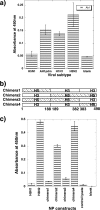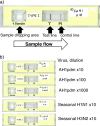Development of an immunochromatographic assay specifically detecting pandemic H1N1 (2009) influenza virus
- PMID: 20071549
- PMCID: PMC2832444
- DOI: 10.1128/JCM.02262-09
Development of an immunochromatographic assay specifically detecting pandemic H1N1 (2009) influenza virus
Abstract
The pandemic caused by a new type of influenza virus, pandemic H1N1 (2009) influenza virus A (AH1pdm), has had a major worldwide impact. Since hemagglutinin (HA) genes are among the most specific genes in the influenza virus genome, AH1pdm can be definitively diagnosed by viral gene analysis targeting the HA genes. This type of analysis, however, cannot be easily performed in clinical settings. While commercially available rapid diagnosis kits (RDKs) based on immunochromatography can be used to detect nucleoproteins (NPs) of influenza A and B viruses in clinical samples, there are no such kits that are specific for AH1pdm. We show here that an RDK using a combination of monoclonal antibodies against NP can be used to specifically detect AH1pdm. The RDK recognized AH1pdm virus isolates but did not recognize seasonal H1N1 and H3N2 and influenza B viruses, indicating that the specificity of the RDK is 100%. A parallel comparison of RDK with a commercial influenza A/B virus kit revealed that both types of kits had equal sensitivities in detecting their respective viruses. Preliminary evaluation of clinical samples from 5 individuals with PCR-confirmed human AH1pdm infection showed that the RDK was positive for all samples, with the same detection intensity as that of a commercial influenza A/B virus kit. This RDK, together with a new vaccine and the stockpiling of anti-influenza drugs, will make aggressive measures to contain AH1pdm infections possible.
Figures




Similar articles
-
Development of two types of rapid diagnostic test kits to detect the hemagglutinin or nucleoprotein of the swine-origin pandemic influenza A virus H1N1.Clin Vaccine Immunol. 2011 Mar;18(3):494-9. doi: 10.1128/CVI.00269-10. Epub 2011 Jan 12. Clin Vaccine Immunol. 2011. PMID: 21228147 Free PMC article.
-
Multicenter prospective evaluation of a novel rapid immunochromatographic diagnostic kit specifically detecting influenza A H1N1 2009 virus.J Clin Virol. 2011 May;51(1):68-72. doi: 10.1016/j.jcv.2011.01.007. Epub 2011 Feb 15. J Clin Virol. 2011. PMID: 21324735 Clinical Trial.
-
Monoclonal antibody kit for identification of the novel 2009 H1N1 influenza A virus.J Clin Microbiol. 2010 Aug;48(8):2677-82. doi: 10.1128/JCM.00978-10. Epub 2010 Jun 2. J Clin Microbiol. 2010. PMID: 20519459 Free PMC article.
-
Sensitivity of a marketed immunochromatographic assay specifically targeting the pandemic influenza A/H1N1 2009 virus.Diagn Microbiol Infect Dis. 2010 Sep;68(1):80-2. doi: 10.1016/j.diagmicrobio.2010.05.005. Diagn Microbiol Infect Dis. 2010. PMID: 20727475
-
Comparative analytical sensitivities of six rapid influenza A antigen detection test kits for detection of influenza A subtypes H1N1, H3N2 and H5N1.J Clin Virol. 2007 Feb;38(2):169-71. doi: 10.1016/j.jcv.2006.11.010. Epub 2006 Dec 27. J Clin Virol. 2007. PMID: 17194622
Cited by
-
Development of two types of rapid diagnostic test kits to detect the hemagglutinin or nucleoprotein of the swine-origin pandemic influenza A virus H1N1.Clin Vaccine Immunol. 2011 Mar;18(3):494-9. doi: 10.1128/CVI.00269-10. Epub 2011 Jan 12. Clin Vaccine Immunol. 2011. PMID: 21228147 Free PMC article.
-
Development of a Specific and Rapid Diagnostic Method for Detecting Influenza A (H1N1) pdm09 Virus Infection Using Immunochromatographic Assay.Osong Public Health Res Perspect. 2013 Dec;4(6):342-6. doi: 10.1016/j.phrp.2013.10.006. Epub 2013 Nov 7. Osong Public Health Res Perspect. 2013. PMID: 24524023 Free PMC article.
-
Two years after pandemic influenza A/2009/H1N1: what have we learned?Clin Microbiol Rev. 2012 Apr;25(2):223-63. doi: 10.1128/CMR.05012-11. Clin Microbiol Rev. 2012. PMID: 22491771 Free PMC article. Review.
-
Altered specificity of single-chain antibody fragments bound to pandemic H1N1-2009 influenza virus after conversion of the phage-bound to the soluble form.BMC Res Notes. 2012 Sep 4;5:483. doi: 10.1186/1756-0500-5-483. BMC Res Notes. 2012. PMID: 22943792 Free PMC article.
-
Subsisting H1N1 influenza memory responses are insufficient to protect from pandemic H1N1 influenza challenge in C57BL/6 mice.J Gen Virol. 2013 Aug;94(Pt 8):1701-1711. doi: 10.1099/vir.0.049494-0. Epub 2013 Apr 11. J Gen Virol. 2013. PMID: 23580424 Free PMC article.
References
-
- Chan, K. H., S. Y. Lam, P. Puthavathana, T. D. Nguyen, H. T. Long, C. M. Pang, K. M. Chan, C. Y. Cheung, W. H. Seto, and J. S. Peiris. 2007. Comparative analytical sensitivities of six rapid influenza A antigen detection test kits for detection of influenza A subtypes H1N1, H3N2 and H5N1. J. Clin. Virol. 38:169-171. - PubMed
-
- Ehara, N., K. Fukushima, H. Kakeya, H. Mukae, S. Akamatsu, A. Kageyama, A. Saito, and S. Kohno. 2008. A novel method for rapid detection of Streptococcus pneumoniae antigen in sputum and its application in adult respiratory tract infections. J. Med. Microbiol. 57:820-826. - PubMed
-
- Frens, G. 1973. Controlled nucletion for the regulation of the particle size in monodiperse gold suspensions. Nature 241:20-22.
-
- Fujimoto, T., T. Okafuji, T. Okafuji, M. Ito, S. Nukuzuma, M. Chikahira, and O. Nishio. 2004. Evaluation of a bedside immunochromatographic test for detection of adenovirus in respiratory samples, by comparison to virus isolation, PCR, and real-time PCR. J. Clin. Microbiol. 42:5489-5492. - PMC - PubMed
Publication types
MeSH terms
Substances
LinkOut - more resources
Full Text Sources
Other Literature Sources
Medical
Miscellaneous

